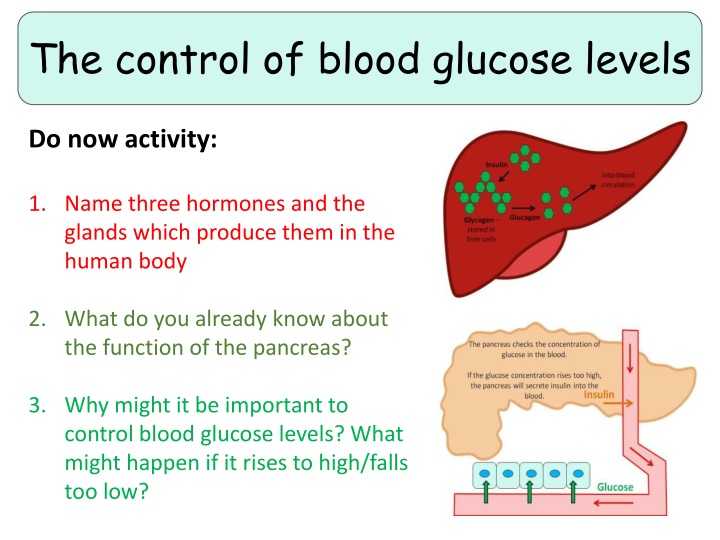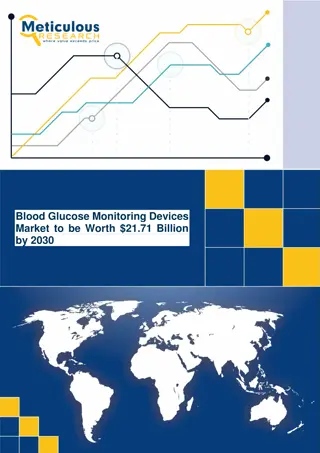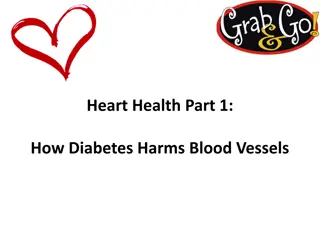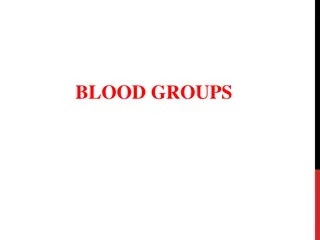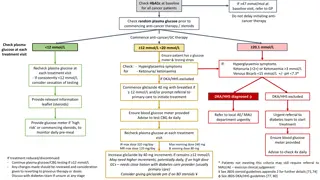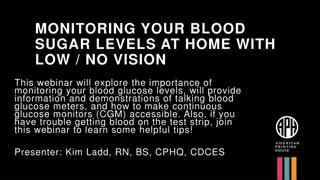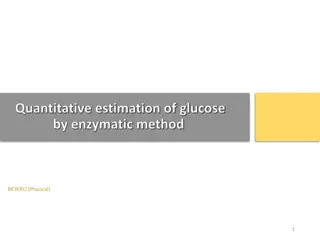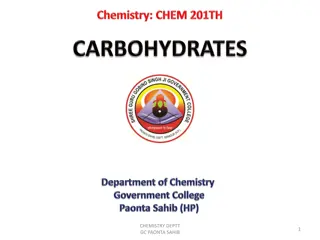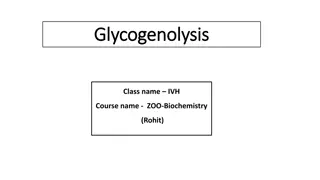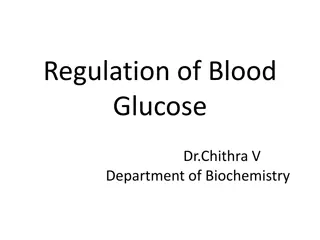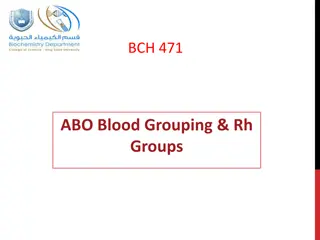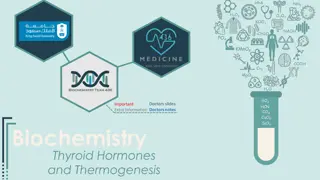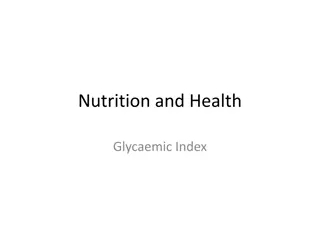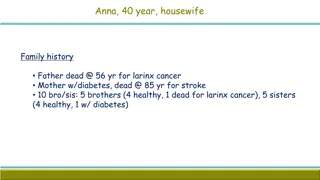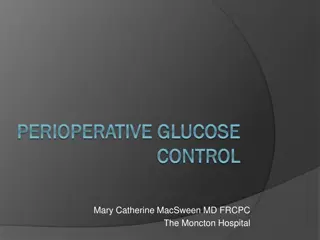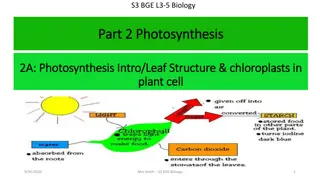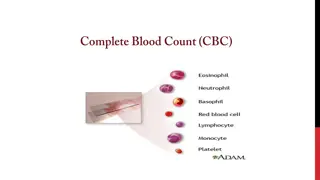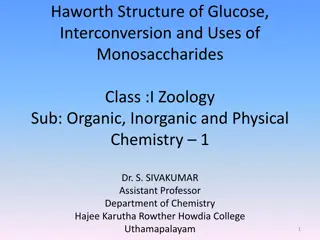Blood Glucose Control Mechanisms in the Human Body
This content explores the regulation of blood glucose levels in the human body, covering the role of hormones like insulin and glucagon produced by the pancreas. It discusses the importance of maintaining proper blood glucose levels and the consequences of levels being too high or too low. The text also touches on how glucose is transported and utilized by cells, emphasizing the critical functions of the pancreas in monitoring and controlling blood glucose concentration.
Download Presentation

Please find below an Image/Link to download the presentation.
The content on the website is provided AS IS for your information and personal use only. It may not be sold, licensed, or shared on other websites without obtaining consent from the author.If you encounter any issues during the download, it is possible that the publisher has removed the file from their server.
You are allowed to download the files provided on this website for personal or commercial use, subject to the condition that they are used lawfully. All files are the property of their respective owners.
The content on the website is provided AS IS for your information and personal use only. It may not be sold, licensed, or shared on other websites without obtaining consent from the author.
E N D
Presentation Transcript
The control of blood glucose levels Do now activity: 1. Name three hormones and the glands which produce them in the human body 2. What do you already know about the function of the pancreas? 3. Why might it be important to control blood glucose levels? What might happen if it rises to high/falls too low?
Progress indicators GOOD PROGRESS: Describe how blood glucose concentration is monitored and controlled. Explain when insulin is produced and how it helps to control blood glucose levels OUTSTANDING PROGRESS: Explain how insulin and glucagon work together to control blood glucose levels. HT: Explain when glucagon is produced by the pancreas and its effect on blood glucose levels.
Glucose is transported around the body dissolved in blood plasma. Cells take in the glucose and combine it with oxygen in respiration, this releases energy. If blood glucose levels drop too low then cells may not get enough energy. If blood glucose levels rise too high, then water is drawn out of the body cells by osmosis and this can do permanent harm. Task: In pairs, discuss how you think a rise in blood glucose or a fall in blood glucose levels might affect somebody Brain cells are the first to be affected.
So how does your body keep your glucose levels at a constant? Your pancreas monitors and controls the level of glucose in your blood using two hormones, the best known is insulin. If blood glucose concentration rises The soluble glucose is moved into cells and either used by your cells or stored as insoluble glycogen.
So what if the blood glucose concentration is too low? The other important hormone needed to control blood glucose concentration is glucagon. Glucagon makes your liver break down glycogen, turning it back into soluble glucose which then diffuses back into the blood.
Regulation of blood glucose levels https://www.youtube.com/watch?v=y9Bdi4dnSlg ________ monitors blood glucose concentration Blood glucose too high Blood glucose too low __________ is released by the __________ and _________ stops being released __________ is released by the ____________. Glucagon tells the liver to break __________ in to glucose and release this into the _________ Insulin tells the ________ to take ___________ out of the blood and turn it into glycogen and store it. Blood glucose back to normal Blood glucose back to normal Task: Complete the flow diagram in your books
Self-assessment: Pancreas Glucagon pancreas Insulin insulin pancreas liver glucose glucose blood
Monitoring blood glucose Key Words Task: Copy the table below into your books, in groups you will be given a set of cards which can be used to fill in the missing the boxes: Key Word Insulin Role A hormone released by the pancreas to help increase the blood glucose concentration Insoluble form of glucose that is stored together in long chains. It is stored in the liver. Liver Pancreas
Self-assessment: Key Word Definition A hormone released by the pancreas to help decrease the blood glucose concentration A hormone released by the pancreas to help increase the blood glucose concentration Insoluble form of glucose that is stored together in long chains. It is stored in the liver. This is the site of many metabolic reactions, it stores glucose as glycogen. The gland that monitors the blood glucose levels in your body, it will secrete insulin or glucagon as appropriate. Insulin Glucagon Glycogen Liver Pancreas
Quick Check: Silent 5 Task: ON YOUR OWN, answer the following questions in your book in silence 1. Name the organs involved in regulating blood glucose 2. How do these organs regulate blood glucose levels? 3. How can blood glucose levels increase? 4. How can blood glucose levels decrease? 5. Name the 2 hormones released by the pancreas 6. What is glucose stored as in the liver? 7. How is this form of glucose released when blood glucose levels are too low? 8. What is the response when blood glucose levels are too high?
Self-assessment: 1. Brain, liver and pancreas 2. By releasing hormones 3. Eating or drinking food/drink that contains sugar 4. Exercising - respiring 5. Insulin and glucagon 6. Glycogen 7. Glucagon 8. Insulin released from the pancreas
What causes diabetes? Task: Watch the video and try to answer the following questions: 1. What is the difference between type 1 and type 2 diabetes? 2. What are the main symptoms of both types of diabtes? 3. What are the risk factors of Type 2 diabetes? 4. How could you reduce the risk of developing type 2 diabetes? https://www.youtube.com/watch?v=aq4Mv0qqWe0
Self-assessment: 1. Type 1 diabetes is when no insulin is produced by your pancreas and Type 2 diabetes is either there is not enough insulin produced by your pancreas or it is being produced but not working properly. 2. Symptoms of Type 1 and Type 2 diabetes are thirst, needing to urinate frequently, tiredness and weight loss. 3. The risk factors for Type 2 diabetes are being overweight, a family history of the disease, high blood pressure, poor diet and lack of exercise, age and ethnicity South-Asians have a greater risk. 4. You can reduce your risk of Type 2 diabetes by maintaining a healthy body weight, exercising for 30 minutes each day can also reduce your risk by 40%
Task: Exam-style question 1.What is the name of an organ which released hormones? (1) 2.How do hormones travel around the body? (1) 3.Explain the cause of diabetes and how it is controlled. (3)
Self-assessment: 1. In the blood / bloodstream / circulatory system 2. Released by glands (endocrine gland) 3. The pancreas Does not produce enough insulin / cannot control the blood sugar levels properly One medical treatment insulin injections / inhaler Balanced diet / exercise
Plenary Summarise what you have learnt this lesson in 3 sentences
Glycogen Glycogen Glucagon Glucagon A hormone released by the pancreas to help decrease the blood glucose concentration A hormone released by the pancreas to help decrease the blood glucose concentration This is the site of many metabolic reactions, it stores glucose as glycogen. The gland that monitors the blood glucose levels in your body, it will secrete insulin or glucagon as appropriate. This is the site of many metabolic reactions, it stores glucose as glycogen. The gland that monitors the blood glucose levels in your body, it will secrete insulin or glucagon as appropriate.
